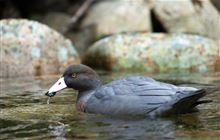Ten the lucky number for whio
Archived content: This media release was accurate on the date of publication.
Introduction
Whio, the iconic rapid-riding blue ducks which feature on the $10 note, are being celebrated today.Date: 09 March 2022
March 10 marks over 10 years of partnership between the Department of Conservation and Genesis Energy on the Whio Forever Programme. The partnership provides resources and technical expertise to support whio work nationally.
Over the lifetime of the partnership the number of protected whio breeding pairs has nearly tripled, growing from 298 pairs in 2011 to 863 in 2021.
Stoats, ferrets and cats are the ducks’ worst enemies, with whio especially vulnerable during nesting time, and when females are in moult and can’t fly. Genesis’ investment has included funding for over 5000 traps protecting nearly 1700 km of river networks.
“The partnership is a glowing example of how commercial partners can be involved in conservation. It has fostered great community engagement and public awareness,” says DOC Biodiversity Ranger Andy Glaser. “People are involved in their own awa, caring for these taonga species. It demonstrates what can be achieved when we all focus on a simple action such as trapping.
“This year we are commemorating all the hard mahi that has gone into protecting the whio over the past 10 years.”
Genesis’ General Manager of Sustainability, Kate van Praagh, says Genesis is proud to reach the 10-year milestone in the partnership, which has proven such a success for whio.
“A healthy whio population means healthy rivers, which we share with whio to generate electricity for New Zealanders. We’re pleased to support DOC in ensuring this important species continues to thrive.”
The work is supported generously by countless volunteers, community groups, iwi and schools who trap for whio, and wildlife organisations that run breed-for-release programmes to boost whio numbers.
Whio are celebrated annually in March as that’s the time when captive-bred young adult ducks are released into the wild.
Background Information
- The whio is a threatened species of native duck found only in New Zealand’s fast flowing waters. With an estimated nationwide population of less than 3000 birds, whio are rarer than some species of kiwi.
- Whio are adapted to live on fast-flowing rivers so finding whio means you will also find fresh, fast-flowing water with a good supply of plants and underwater insects.
- This makes whio important indicators of ecosystem health – they only exist where there is quality fresh water and an abundance of life.
- Whio cannot be moved to predator-free islands like other species because of their reliance on fast-flowing rivers.
Contact
For media enquiries contact:
Email: media@doc.govt.nz

